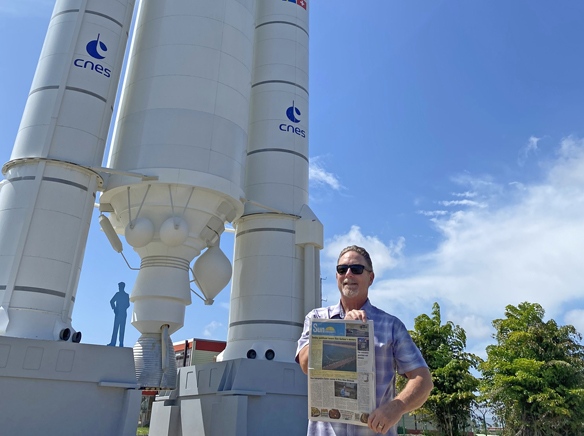
In just over 12 days, NASA, in conjunction with several other entities, will launch the James Webb Space Telescope. The JWST is the successor to the Hubble Space Telescope, but is considered more of a space observatory.
The JWST has revolutionary new technology That will allow it to study cosmic history. It will not only be able to provide new insight to our galaxy, but also to the most distant observable galaxies in the early universe. Its infrared telescope will be able to help scientists better understand and observe the origins of the universe, according to NASA’s JWST website.
“It will build upon the discoveries of other missions to answer fundamental questions about the universe and its origins,” NASA website states.
Former Seal Beach, and current Los Alamitos resident, Steve Huff is currently in French Guiana, on the north coast of South America, where the JWST and its launch vehicle are being prepped to launch on Dec. 22. Huff is part of the team launching the 14,000-pound observatory, as the NASA Mission Assurance Lead.
After serving in the Marine Corp. Huff went to work for TRW Space, which was acquired by Northrup Gruman in the early 2000s. He went to work for NASA in 2018, but has been part of the JWST program in the overlap.
“I worked on many spacecraft programs over my 34-year career, landing on the JWST Program in 2012, so I’m 10 years in,” Huff said.
As a Mission Assurance Lead, he coordinates a quality control team that is involved on all aspects of building a spacecraft. The JWST has a main mirror that is more than 21 feet in diameter. It was built as a collaborative effort between NASA, the European Space Agency and the Canadian Space Agency. According to reports, the project involved the efforts of more than 300 universities, organizations and companies in 14 countries. The components were primarily assembled at Northrop Grumman Space Systems in Redondo Beach.
It was shipped from the Naval Weapons Station Seal Beach in September for its trip to the northeast coast of South America, via the Panama Canal.
It will be launched with a Ariane 5, European heavy-lift space launch vehicle, developed and by Arianespace for the European Space Agency. Once it reaches space will travel to its orbit spot, nearly 1 million miles from earth, where it will orbit the sun, in line with earth.
The James Webb Space Telescope (The Observatory) is comprised of three main Elements :
1) Optical Telescope Element (OTE), comprised of the actual space observing Primary Mirror Segments, Secondary Mirror and Tertiary (3rd) Mirror and the science instruments that will process images within their unique mission parameters.
2) The Sunshield Element (SSE), comprised of the 5 layers of coated Kapton material (The size of a tennis court) that will shield the super cold OTE from the warming effects of the Moon, Earth and Sun.
3) The Spacecraft Element (SCE), which is the actual power, communication and station keeping segment of the Observatory.
For more info, and to join launch watch groups, start by visiting webb.nasa.gov. Follow on social media at @NASAwebb or NASAwebb on Twitter and Instagram.











